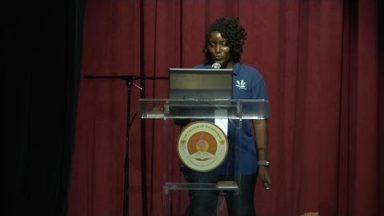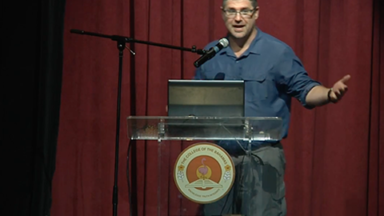Vegetation History of Eleuthera, Bahamas: Pollen and Charcoal Analysis of Sediment Cores from Two Sites
Presented by Eric Kjellmark
Eric Kjellmark, Lisa Park Boush, Ilya Buynevich, Amy Myrbo, Mary Jane Berman, Perry Gnivecki, and Eric Brown
In 2012, sediment cores were recovered from two sites on Eleuthera Island, Bahamas. Samples from both cores were processed for pollen and charcoal analysis in order to reconstruct the vegetation and fire history around each site. The first core was 254 cm long and was obtained from Shad Pond near the coast on the south end of Eleuthera. The second core was 140 cm long and was obtained from Duck Pond Blue Hole in the middle of the island north of Weymes Bight. The sediment from the 180-240 cm depth in the Shad Pond core is a fibrous peat and dates from ~3700 to 4800 cal yBP . The pollen spectrum in the peat is dominated by red mangrove (Rhizophora mangle) suggesting that the site was a red mangrove-dominated swamp during this period. The sediment from 100 to 140 cm depth in the Duck Pond core is a pure, fine calcareous mud with only small traces of pollen present. The pollen spectrum in middle portion of both cores is dominated by palm with pollen from rockland and coppice species also present. Palm pollen declines in sediments from both cores at depths that date to ~1100-1300 cal yBP, the time of Lucayan occupation. Palm pollen nearly disappears from Shad Pond sediments younger than ~1300 cal yBP and its sudden drop is coincident with a significant spike in charcoal particles. Palm pollen drops by over ½ in Duck Pond sediments younger than ~1100 cal yBP, but there is initially only a modest increase in charcoal particles. Palm pollen returns in modest amounts toward the top of the Shad Pond core and there is a second, smaller peak in charcoal in sediments that date to ~200-300 cal yBP. This suggests a recovery of palms near the coast beginning in the plantation period. Palm gradually declines toward the top of the Duck Pond core while pollen from Trema lamarckianum, a disturbance indicator, becomes very dominant. Charcoal is most abundant in Duck Pond sediments that date to ~200-300 cal yBP and later. The decline of palm pollen and increase in pollen from disturbance species in sediments from both sites ~1100-1300 cal yBP suggests heavy exploitation of palms by Lucayans, particularly near the coast. The later increase in charcoal and significant increase in pollen from disturbance species in sediments from the inland Duck Pond site ~200-300 cal yBP suggests land clearing during the Plantation Period.crabs as pets.







Recent Comments